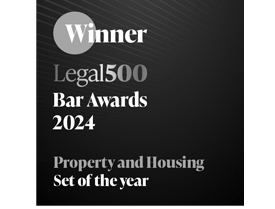Encroaching tenants: problem solved? 30 September 2025
A tenant, T, absorbs into the land leased to them additional land belonging to the landlord, L. T remains in exclusive possession for many years. What is the status of T against L? The label attached to this situation is “encroachment”. It appears to have its origins in the law about encroachments on the waste of a manor by a tenant of the lord of the manor. It is clear however that it is not limited to manorial wastes. It now applies to all land.
What is the basis of the law of tenant encroachments?
The law of encroachment is unclear. It has developed piecemeal over three centuries. It seems to owe something to the law of limitation – long use generates those rights. It also appears to owe something to the law of estoppel – the tenant is prevented from denying the title of his landlord (or lord), unless there is something that made it plain that the encroachment was not being done in the capacity of tenant. Indeed, in Ali v Tower Hamlets LBC [1996] EGCS 193, Jonathan Sumption QC (as he then was) sitting as a Deputy Judge of the High Court thought that the doctrine was based on proprietary estoppel – though it is difficult to see how that would operate in many cases. Presumably he had in mind that this would be an estoppel arising by acquiescence – though it is hard to see how this could be made out on the facts (and why it would be satisfied in all cases by a mere addition to the demised premises).
On top of that, the following developments add to the confusion:
- It had been thought that L could not recover possession of the encroached land even if no limitation period had expired: Tabor v Godfrey (1895) 64 LJQB 245. However more modern authority suggests that before time has expired, L can evict T from the additional land unless there is an estoppel or licence in place: Smyrk v Lyndale Developments [1975] Ch. 317.
- The law has taken different views over time as to whether L’s permission stops T from being able to take advantage of the presumption. It used to be thought that permission fortified the presumption (which would suggest that it has nothing to do with adverse possession): Whitmore v Humphreys (1871) LR 7 CP 1. It is now thought permission rebuts it: Ali v Tower Hamlets LBC.
- The presumption also applies where the land encroached upon is third-party land. In such a case, the additional land is presumed to form part of the demised land, and L can lay claim to the freehold when the term expires. That would suggest that limitation is the basis of L’s claim at the least.
Those developments appear to suggest that limitation is strongly in play, and limitation is the “best fit” in the sense that in most cases it is long use by T that is generative of rights, with estoppel-based concepts like representation, acquiescence and detrimental reliance playing little part in the process. That would, however, be a hasty conclusion.
The Chau Ka Chik Tso Case
The first case to consider is from Hong Kong. This is Secretary of Justice v Chau Ka Chik Tso [2011] HKCFA 86. Given that land is leased in Hong Kong, the doctrine of encroachment has attained a particular prominence there. That case concerned a long lease of a fish farm which was extended beyond the original demise by T. T claimed that additional land as an accretion to their lease. The Court of Final Appeal agreed with T.
Although there was unanimity on the outcome, there was a split on the analysis. The 3:2 majority decided that the doctrine of accretion was indeed (as the direction of travel in the cases cited above suggested) an aspect of the law of limitation, and hence adverse possession. Lord Scott, for the majority, expressed the view that the atypical (for adverse possession) outcome that T acquired only a leasehold and not (as is the normal case) a freehold was explicable by reference to T’s actual intention, to be a leaseholder only (which is consistent with the cases in Jourdan and Radley-Gardner, Adverse Possession, at 20-19 – 31). Ribiero PJ, giving the minority judgment thought that adverse possession was not the right analysis. It was inconsistent with the statutory effect of adverse possession, which is to extinguish L’s title (and not to generate an additional leasehold for L). Instead, an estoppel was generated between L and T whereby T was precluded from asserting that L’s title had been extinguished. Absent that estoppel, limitation would operate to that effect. It is however difficult to see how an estoppel can be generated that creates an automatic leasehold interest by unilateral action absent proof of acquiescence. It is also not clear why the estoppel in such a case can only ever generated a leasehold interest on the same terms as T’s pre-existing lease, and no other interest. The only estoppel that generates rights is proprietary estoppel, and the Court always has a remedial discretion where such an estoppel is generated.
Neither the majority nor the minority appear to have given an answer that restores encroachment neatly to a particular legal doctrine.
Schedule 6 to the Land Registration Act 2002
That raises a practical question in this jurisdiction. Is encroachment adverse possession or not? If it is, then T must bring themselves within Schedule 6, and in particular, if required to do so, establish that one of the conditions for being registered as a squatter is met. T must then be registered – somehow – with a leasehold title. If T is not within Schedule 6, because encroachment is not adverse possession, then the conditions do not apply to T, and no application under the adverse possession procedure need be made.
There has been some uncertainty as to whether the Tribunal in England and Wales will follow Lord Scott or Ribiero PJ’s analysis. The early indications appear to have favoured Lord Scott’s approach: see Patterson v. Thomas (REF/2018/1036).
That changed in two recent cases before the First Tier Tribunal (Land Registration). Both concerned enclosure of loft space above top floor flats and not included in the original demise. The first of the cases is McGee v Long Term Reversions (Harrogate) Limited REF/2023/0552, and the second is Hood v Southern Land Securities Ltd REF/2023/0687. Both cases proceed on the basis that the minority judgment of Ribiero PJ is the correct approach = that the doctrine is estoppel-based. The expiry of the limitation is a necessary pre-condition for the estoppel to operate. Once it has arisen, it operates in two ways – the tenant is estopped from arguing that the encroachment is not subject to the tenancy, and the landlord is estopped from denying that it is. As the outcome of the operation of the doctrine is the creation of an extension to T’s leasehold interest, and not the acquisition of L’s estate, Schedule 6 does not apply.
In McGee, T applied in form ADV-1 on the basis that this was a case of adverse possession within Schedule 6. T invoked paragraph 5(4) (reasonable mistake as to boundary). A Land Registry requisition noted this was a case of encroachment and that therefore an application for first registration of a leasehold estate (FR-1) was the right application to make. This led to a withdrawal of the ADV-1 and the making of an FR-1 application instead. L objected on the basis of Schedule 6, treating the FR-1 application as an application under that Schedule. Following a careful analysis of the case law, including Patterson, Judge Green concluded that the Ribiero PJ analysis was to be preferred – that is to say that a period of limitation had to expire, which generated an estoppel as between L and T which was rebuttable on the facts.
In Hood, an application was made in form AP-1, and not, as would be necessary for adverse possession, ADV-1 under the 2002 Act and the associated rules. The application was to alter the register to update it to record the encroachment, under Schedule 4, paragraph 5(b) of the 2002 Act. Although in Hood L tried to invoke paragraph 6 in response to that application, the Land Registry stated repeatedly that it was not dealing with an adverse possession application, which position was not made the subject of a judicial review. The Tribunal therefore did not confront that issue in Hood, but proceeded on the assumption that the sole question to be addressed was whether T had been in adverse possession – and he had been.
The above approach is consistent too with the published guidance of the Land Registry: So, it would seem, the present position: see section 11.2 of Practice Guide 4, Adverse Possession of Registered Land. So, as matters stand, it appears that the law in England is settled on the Ribiero PJ analysis.
Conclusions
It does appear right that the law of encroachments is not based purely on limitation. There seems to be no good policy reason to disapply limitation altogether – it seems frankly indefensible for the doctrine to operate on day one. That said, too much can be made of an analysis based on estoppel – in particular, the notion that the doctrine is based on proprietary estoppel. The latter may explain the right-generating nature of encroachment, but for reasons already stated it does not appear to fit. The rights to be conferred in satisfaction of a proprietary estoppel are the subject of judicial discretion, whereas in the case of encroachment the result is an automatic leasehold interest. It is not obvious why in cases of enclosure within a flat of roof voids and lofts, it could be said to be unconscionable for L to seek their property back. It will also be hard to argue acquiescence, which in practice is the form of proprietary estoppel that is likely to fit the facts (given that a representation-based estoppel would seemingly prevent the doctrine of encroachment from applying in any event). A pure estoppel analysis would seem also to require the countervailing benefits of T to be taken into account – such as the gratis use of land that was not demised.
The temptation to explain the doctrine on the basis of estoppel of some kind is apt to lead to confusion, as it imports suggestions of discretion and unconscionability, when those concepts in fact are not in play (indeed the doctrine equally assists the devious). It should be left behind at this point. Instead, encroachment should be perhaps be seen as a distinct branch of the law relating to lost modern grants, a facet of the wider principle that conduct that has gone on for long enough will be deemed to have had a lawful origin (here, a leasehold). Although used in connection with easements, it can also lead to other documents being presumed, from a lost ministerial consent (Re Edis’ Declaration of Trust [1972] 1 W.L.R. 1135) to a lost port authority regulation (AG v Wright [1897] 2 Q.B. 318). That said, it cannot be pretended that this is a perfect home either.
Whatever the label that is deployed, the modern development of the old law of encroachment has not settled one thing – it isn’t adverse possession (though it is adverse possession-adjacent).
*
Stephen Jourdan KC, Oliver, and Julia Petrenko are presently working on the third edition of Adverse Possession, which continues to generate litigation.
Download: Encroaching tenants: problem solved?
Back to articles






